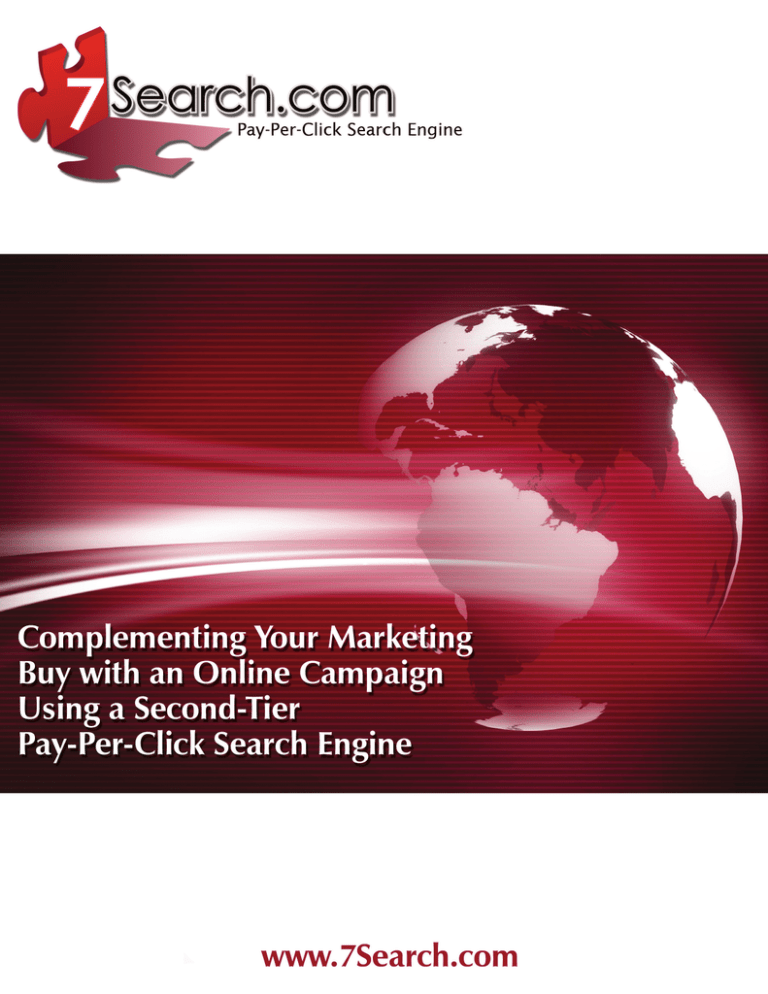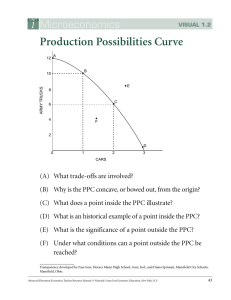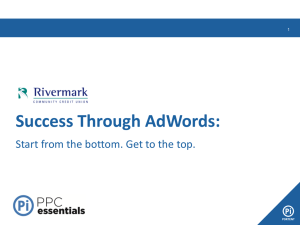
Pay-Per-Click Search Engine
_____________________________________________________________________________________800.577.1165 | 7Search.com | 1
Pay-Per-Click Search Engine
Table of Contents
Page 3…………..... Synopsis: 2nd-Tier Offers Greater ROI
Pages 3-4......….... The Internet as an Advertising Medium
Pages 4-5........….. PPC Advertising Leads the Way
Pages 5..........…... Search Engines Drive Traffic
Pages 6…........….. Exposing Your Message to that 22.4 Percent
Pages 6…........….. Affiliate Sites Generate PPC Traffic
Pages 7..........…... Higher ROI for 2nd-Tier PPC Advertisers
Pages 7-8........….. What to Look for in a 2nd-Tier PPC Network
Each white paper by 7Search, Inc. may contain proprietary notices or describe products, services,
processes or technologies owned by 7Search or third parties. Nothing contained herein shall be
construed as granting to the user a license under any copyright, trademark, patent or other intellectual
property right of 7Search or any third party.
2 | 7Search.com | 800.577.1165_____________________________________________________________________________________
Pay-Per-Click Search Engine
Synopsis: 2nd-Tier PPC Search Engines Offers Greater ROI
Marketers have been quick to accept the Internet as an advertising tool, committing the lion’s share of
dollars toward Pay-Per-Click (PPC) advertising with industry leaders Google and Yahoo!, which generate
nearly 92 percent of the PPC market revenue.
Complementary use of 2nd-tier PPC search engines, however, exposes a marketer’s message to the
remaining audience with greater ROI. Advertising with the right 2nd-tier PPC network that follows the
industry’s best practices offers the best chance to cost-effectively increase online sales.
The Internet as an Advertising Medium
Since 2000, there has been a 77 percent increase of Americans who use the Internet.
Data source: Internet World Statistics
Not only are there more users online, but today’s surfers spend greater parts of their day browsing the
Internet. According to Nielsen/Net Ratings, during July 2008, the average web usage per person AT
HOME was 34 sessions, totaling 32 hours and 40 minutes on the computer.
AT WORK, the average user logged 65 sessions, totaling 84 hours and nine minutes on the computer.
The average number of web domains visited was 123. These figures represent a 13 percent increase
from 2006 to 2008 of time at home dedicated to Internet use. Similarly, at work, there was an 11
percent increase of time spent online.
The astoundingly fast and growing acceptance of the Internet as an outlet for shopping, research, news,
entertainment and other content forced American businesses to adapt quickly by incorporating the new
medium into their marketing plans.
According to the Interactive Advertising Bureau (IAB), in 2007, U.S. marketers spent $21.1 billion on
Internet advertising, a 25 percent increase over 2006. During the first quarter of 2008, the IAB reports
_____________________________________________________________________________________800.577.1165 | 7Search.com | 3
Pay-Per-Click Search Engine
that Internet advertising revenues reached $5.8 billion, an 18.2 percent increase over the same period
in 2007.
PPC Advertising Leads the Way
According to eMarketer, since 2003, the largest slice of online advertising in the U.S. is accounted for by
pay-per-click.
Note: eMarketer benchmarks its US online advertising
spending projections against the Interactive Advertising
Bureau (IAB)/Pricewaterhousecoopers (PwC) data, for
which the last full year measured was 2006; paid search
includes contextual text links
Data Source: eMarketer; April 2007
Since 2000, when paid search advertising in the U.S. was at $108.5M, there has been a 76-fold increase
in category spending through 2007.
Data Source: Internet World Statistics
Although percentage growth of PPC spending has remained nearly level since 2003, this fact is obscured
4 | 7Search.com | 800.577.1165_____________________________________________________________________________________
Pay-Per-Click Search Engine
by the exponential growth of overall Internet advertising spending. In fact, spending on PPC alone in
2008 will exceed the $9.626 billion that was spent for online advertising in 2004.
Quarterly Internet Ad Revenues
$6,000
1997
1998
1999
2000
$907
$1920
$4621
$8087
2001
$7134
2002
2003
2004
2005
$6010
$7267
$9626
$12542
2006
2007
$16879 $21206
Q1’08
$5792
$5,500
$5,000
$4,500
$4,000
$3,500
$3,000
$2,500
$2,000
$1,500
$1,000
$500
1Q
tr
2Q
tr
3Q
t
4Q r
tr
1Q
tr
2Q
tr
3Q
t
4Q r
tr
1Q
tr
2Q
tr
3Q
t
4Q r
tr
1Q
tr
2Q
tr
3Q
t
4Q r
t
1Q r
tr
2Q
tr
3Q
t
4Q r
tr
1Q
tr
2Q
tr
3Q
t
4Q r
tr
1Q
tr
2Q
tr
3Q
t
4Q r
t
1Q r
tr
2Q
tr
3Q
t
4Q r
t
1Q r
tr
2Q
tr
3Q
t
4Q r
tr
1Q
tr
2Q
tr
3Q
t
4Q r
tr
1Q
tr
2Q
tr
3Q
t
4Q r
t
1Q r
tr
$0
Data source: PwC/IAB Internet Advertising Revenue Report
Search Engines Drive Traffic
Like the first television viewers were limited to just three networks (thus exposed to the networks’
advertisers’ messages), the early days of the Internet produced only a few dominant players: Google,
Yahoo!, MSN and Ask. However, as both sales-oriented mediums matured, new outlets entered
the arena.
Source: Compete, Inc. commissioned by MarketingSherpa,
September 2006
Just like there was sufficient audience for more television content, the chart below shows that web
surfers do not use Google, Yahoo!, MSN and Ask exclusively. It is also proof that web surfers often
“change channels,” using more than one search engine during any given month.
_____________________________________________________________________________________800.577.1165 | 7Search.com | 5
Pay-Per-Click Search Engine
Another statistic from eMarketer shows that Google and Yahoo! currently dominate the PPC market,
commanding a collective 91.9 percent segment share.
According to Nielsen Online, Google
and Yahoo! also claimed 60.2 and
17.4 percent, respectively, of all U.S.
Internet searches conducted during
July 2008. That means 22.4 percent
of searches are performed elsewhere.
Exposing Your Message
to that 22.4 Percent
To build or uphold your brand, a
PPC presence on Google and Yahoo!
is a valid advertising expenditure. A
tremendous amount of traffic can be
generated by these industry leaders.
Note: *net of traffic acquisition costs (TAC)
Source: company reports, 2004-2007; eMarketer calculations, February 2007
However, with 91.9 percent of PPC
advertising revenue committed to
just 77.6 percent of the Internet
searches performed, there is a strong
case to be made for supplementing
this expenditure with cost-effective,
2nd-Tier PPC networks to target what
the big boys leave on the table.
Affiliate Sites Generate Traffic for PPC Networks
In its simplest form, PPC requires paying for a prospect to visit your site. To accomplish this, 2nd-tier
PPC search engines analyze web searches, collect related links and direct traffic to advertisers’ sites
from other search engines and websites with unique content ranging from medical information to
shopping portals and everything in between.
One example of an Affiliate website is to provide a service for shoppers to compare prices and features
for specific types of products. These websites do not sell products, but gather the data for comparison
and link to retailers from which a product can be purchased. Another model of an Affiliate site could be
a listing of local service providers, a directory of related product distributors, an index of manufacturers’
websites and links to prevailing building codes.
Regardless of the model, for each click to the PPC advertiser’s site, the Affiliate is paid by the 2nd-tier
search engine for delivering traffic. In turn, the advertiser is charged by the search engine the amount it
agreed to pay per click.
One of the benefits to partner with 2nd-tier PPC search engines is to remain autonomous. The owner
of the Affiliate website is free to create its own brand because the search technology can be private
labeled. This goes a long way toward enticing loyalty by its readers, thus encouraging repeat visitors,
hence, quality traffic for advertisers.
6 | 7Search.com | 800.577.1165_____________________________________________________________________________________
Pay-Per-Click Search Engine
Higher ROI for 2nd-Tier PPC Advertisers
When a company has a PPC agreement with any search engine, they have submitted bids to have their site listed
among query returns for certain keywords. The higher the bid price (compared to competitors’ bids for the
same keyword), the higher the placement will be in the search return lists.
There is no question that the level of traffic generated from a 2nd-tier PPC campaign is much lower than what
Google or Yahoo! can produce. That’s why the going bid rates for keywords on 2nd-tier search engines are
correspondingly lower.
Network
Clicks
Clients
Leads
Cost
Income
Gain
ROI
7Search
771
148
5
$141
$401
$260
184%
Enhance
808
4
0
$19
$14
($5)
(26%)
Miva
385
7
3
$14
$24
$10
71%
Google
774
357
27
$943
$984
$41
4%
Kanoodle
776
13
4
$170
$39
450
41
$612
3
0
$5.69
Yahoo!
Search123
1901
233
($131)
(77%)
$1233
$611
99%
$9.50
$3.81
67%
Data Source: WebsiteMaven.com
What many advertisers do not realize is that 2nd-tier PPC search engines often provide a much better return on
investment (ROI). After all, most marketers would agree that the online origin – Google or a 2nd-tier PPC site
– of a surfer makes very little difference after a sale has been closed. Cost-conscience marketers not only care
about the price paid to bring surfers to their sites, but also the cost to close the sale compared to their gains. In
short, the higher the ROI, the better. Research conducted by Rich Leino of WebsiteMaven.com provides insight
into the actual ROI generated through different PPC networks.
Leino’s Research was performed by following clicks from each PPC network and tracking these through to a
conversion. (A conversion is usually a sale but can be anything that the website owner desires for the user to
do: register for a newsletter, join a forum, participate in a contest, etc.) In Leino’s table, “Gain” is calculated by
subtracting the “Cost” from the “Income.” “ROI” is calculated as a percentage of Gain divided by Cost. (An ROI of
100% means that for every $1 cost, there was $2 in income.)
Using the method of assigning a value to a successful conversion and tracking the cost for each click that
comes from a PPC network, marketers can determine the average cost for each click, as well as how much
income, on average, each click generated. (NOTE: Keyword popularity, bid values and the cost of a product are
variables that alter results.)
As the table indicates, “success” in terms of clicks does not equate directly to cost-effective marketing in terms
of ROI. For example, a company that sells residential mailboxes for $50 probably should not be paying $8 per
click. However, a manufacturer of $2,750 mailboxes for large condominiums could justify this price per click
because their potential gain is much greater.
What to Look for in a 2nd-Tier PPC Network
When choosing a 2nd-tier PPC search engine, it is important for site owners to receive a comprehensive review
of their online business needs with a PPC expert. This includes looking at the site itself to determine “landing
points” to best facilitate a conversion, or desired user action.
_____________________________________________________________________________________800.577.1165 | 7Search.com | 7
Pay-Per-Click Search Engine
The next step is selecting and bidding on keywords that best describe the site content. Although
marketers are intimately familiar with their products and services, this process requires innovative
tools that inventory websites related to specific keywords, as well as other data. With this information,
marketers can see the mindset of the surfer and choose terms that will lead them to their site
cost-effectively. Also, a PPC network that enables real-time tracking of keyword bid prices can help
a site maintain its positional ranking as the popularity (and price) of a search term increases.
Once keywords are chosen and the site is prepared for the PPC campaign to begin, the owner must then
fund an account to pay for clicks directed to their online property. Pending the expected activity and the
bid price for clicks, an initial investment can be as low as $25 in some cases.
To minimize erroneous clicks by prospects that probably will not purchase from a company that caters
to customers in a defined local area, 2nd-tier PPC advertisers can take advantage of text descriptions of
their site to state their location.
Consider the search term “exotic car repair + Belleville.” Because keywords are recognized by search
engines, a repair shop for exotic automobiles located in Belleville, IL, should identify the company’s
suburban St. Louis location in its description so prospects near Belleville, NJ, will bypass their listing.
Similarly, advertisers have the option to refuse or allow traffic from certain countries so to avoid
unwanted clicks from people in locations a company does not serve. As such, prospects from Belleville,
Ontario will not be shown links for the above-mentioned repair shop if the Midwestern service provider
chooses to exclude searches from outside of the U.S.
After these preliminary steps are taken and the campaign begins, the relationship with your PPC network
should not end. Online tools will vigilantly track generated traffic and identify sites from which it came.
To allow site owners the chance to test the campaign’s performance, account management tools give
the ability to tweak keywords, choose variations and bid on new terms to find the combination that
delivers the best ROI. If a site owner prefers one-on-one contact with a PPC expert, it is important that
phone access to real people is available at no cost. Plus, some PPC networks have set up portals for site
owners to chat online privately to discuss their needs.
Another on-going responsibility of the PPC search engine is to fight against – and in some cases – make
retribution for – fraudulent clicks that can drain a site’s PPC funds. A strong fraud detection team must
be in place, which requires a commitment from the PPC network to police its Affiliates. If the PPC
network is not willing to protect an advertiser’s investment into the campaign, this is a good indication
of the type of traffic that can be expected.
Ultimately, all of these factors equate to providing quality traffic so that advertisers receive the best ROI
for their promotional dollar.
About 7Search.com, Inc.:
7Search.com has been a leading Pay Per Click Search Engine Advertising and Affiliate Network since our inception in 1999.
As a Search Engine who is dedicated to value and service for online businesses, 7search.com provides thousands of Web
entrepreneurs with an economical and measurable opportunity to obtain Internet traffic and generate revenue through
their online presence.
7Search.com, Inc. is headquartered in Chicago, IL and is privately held. More information on 7Search is available at
www.7Search.com. Contact 7Search.com to find out how we can increase your ROI through PPC.
www.7Search.com
1-800-577-1165
1-773-283-0170
bizdev@7search.com
Copyright 2008© by 7Search, Inc. All rights reserved.
8 | 7Search.com | 800.577.1165_____________________________________________________________________________________





